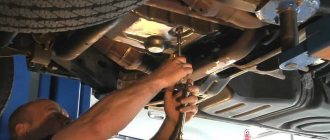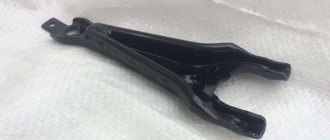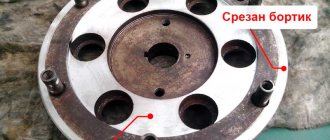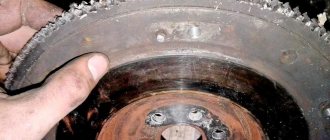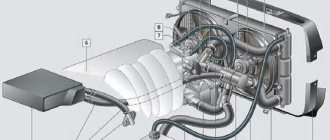The main function of the flywheel is to transmit torque from the crankshaft to the transmission through the clutch. Also, a gear ring is installed on its end part, for which the starter rotates the HF at the moment of starting. But no less important is the effect of smoothing out uneven rotation of the crankshaft, which is best handled by a Dual Mass Flywheel. Let's look at its design, operating principle, malfunctions and methods for diagnosing them.
Characteristic
So what is this element? The damper flywheel (dual-mass) is a mechanical disk-shaped unit. On one side it is attached to the transmission, on the other - to the engine crankshaft. Additionally, it has a ring with teeth, thanks to which it can rotate when the starter gear is engaged. The main task of the element is to transmit and smooth out torsional vibrations that come from the engine.
It is worth noting that the damper flywheel has some differences from conventional ones. Thus, previously, simple flywheels made of disc-shaped cast metal were installed on cars. These elements could not equalize the moment and smooth out vibrations. All impacts went directly to the gearbox and clutch. Let’s look at how exactly the damper flywheel is designed on the T5 and other cars below.
Repair or restoration?
The manufacturer does not intend to disassemble and restore the damper flywheels, so the body parts are connected with rivets. Accordingly, there are no spare parts or parts with repair dimensions for such a unit in the public domain. But due to the considerable cost of original dampers, the restoration service is becoming increasingly popular. Many remain satisfied, but there are also many who, after a couple of tens of thousands of mileage, again encounter symptoms of a malfunction.
It is still difficult to give an unambiguous answer to the question - restore or change. Before contacting specialized workshops, find real clients who have driven at least 20-30 thousand km after restoration. If you are inclined to replace, install only components that are supplied by the manufacturer on conveyors. Luk and Sachs are the largest suppliers of damper flywheels for Skoda, Volkswagen, Ford, BMW and many other brands.
Attention! At the first symptoms of a faulty flywheel, it must be replaced. If signs of failure are ignored, a worn flywheel will quickly kill the clutch, break the input shaft splines, and can cause transmission failure.
Flywheel restoration - pros and cons
If you are sure that the dual-mass flywheel has fallen apart, then there is nothing else to do but prepare for big expenses. If you are unlucky and replacing the flywheel for your car turns out to be too expensive, then a cheaper option is possible - regeneration (about 10,000 rubles). But this path has many opponents, which is not surprising. Manufacturers of dual-mass flywheels do not provide for refurbishment, and therefore do not supply spare parts for their components to the market. However, services specializing in such repairs are supported by extensive accumulated experience and increasingly longer warranties (up to 24 months without mileage limitation). For many owners in a crisis, this is the most economically feasible solution. However, it should be remembered that the warranty is valid if the clutch is also replaced.
Minuses
But there is also another side to the coin. First of all, it is worth noting the price of the mechanism itself. Such an element is very expensive, which certainly affects the cost of the car itself. It is also necessary to note the resource, which is lower than that of single-mass elements. When repairing, you should pay a large amount of money so that the part will again serve its 150-200 thousand kilometers.
But even with such shortcomings, the damper flywheel is increasingly used not only on passenger cars, but also on commercial vehicles. It is technologically more advanced, but at the same time, expensive to repair. You should only buy a car with such a flywheel if there are no obvious signs of wear. Otherwise, you will have to immediately pay about $500, or even more, for repairs. If we talk about new cars with a guarantee, buying cars with a similar flywheel is completely justified here.
How it works?
The primary and secondary disks are two uncoupled masses. They are connected using a spring-damping mechanism mounted on a plain bearing or ball bearing. Torque is transmitted using a flange connected to the driven disk. Its protrusions rest against the pads of the ends of the arc springs.
Thanks to the loose fit on the bearing, the discs can rotate relative to each other. The angle of rotation is limited by the spring travel. It is thanks to this that torsional vibrations are damped on the driven disk. With this design, the manual transmission clutch pressure plate does not require the installation of damping springs.
Design improvement
As engine torque increases, to effectively dampen torsional vibrations, it is necessary to thicken or increase the number of turns of arc springs. But in the case of a constant installation space, tightening the springs will reduce the efficiency of damping vibrations at low speeds. Therefore, the designers resorted to installing internal dampers. The rigid springs mounted in the flange work only in the medium and high speed zone. The design retains soft arc springs that smooth out torque pulsations at idle and in the low-speed zone.
What does the device consist of?
This is not a simple “piece of iron”; the structure here is much more complex. The structure of flywheels with two masses is different. As it becomes clear, here there are, as it were, two disks that are combined into one device (two masses). Each of the masses is attached to its source - one to the engine, the other to the gearbox. Moreover, these two disks can rotate freely from each other; they are connected only by a bearing
However, this way we won’t “move” the car; we need the torque to be transmitted from the power unit to the box and then to the wheels. That is, these two masses need to be somehow connected to each other. THIS is what the internal parts of the structure do, namely springs, flanges (they come in many types - asterisk, polygon, gear). The whole thing is closed with an airtight sealing cap. It is worth noting that the springs and internal cavity are often filled with lubricant
Let's look at a small diagram
This is one of the most common types, there are others, but they all have the same principle
Pros of a flywheel
Is it worth buying a car with a similar mechanism? To answer this question, you need to consider all the pros and cons of the device. So among the advantages it is worth noting:
- Smoother gear shifting.
- Increased service life of internal combustion engine and transmission parts (since they are not subject to increased vibration load).
- Reduced inertial moment when switching speeds.
- Saving space in the clutch housing. This is an important point for cars with a small displacement.
What shortens the life of a double flywheel?
The owner himself, and above all, his driving style, has a great influence on the lifespan of the DMF. But that's not all. There are many more factors influencing the durability of this unit.
"Eco riding" Changing gears too frequently (as the electronic assists like to suggest) and driving on the edge of the engine's "shake" is fatal to the flywheel in the long run. The unit suffers even more during acceleration from very low speeds.
Sports riding. Just because an economical driving style finishes off the flywheel doesn't mean a radically different driving style will be healthier. Sharp accelerations cause strong jerks, which also heavily load the torsional vibration damper.
Movements with load. Towing a trailer or regularly hauling heavy loads will eventually destroy not only the clutch, but also the flywheel. The DMF overheats, which in turn leads to lubricant leakage from the chamber where the springs operate.
City driving. The dual-mass flywheel experiences the most loads when driving in a jagged city rhythm. Constant starting and acceleration is a real challenge for the flywheel. No less harmful is the constant switching off and starting of the engine, so it is recommended to use the start-stop system headlong and in moderation.
Chip tuning. The dual-mass flywheel is designed to suit specific loads. Standard DMF may not withstand higher loads.
Technical condition of the car. Uneven engine operation, for example due to a faulty injection system, is another source of vibration that aggravates the life of the flywheel. Long-term operation with a faulty motor reduces the service life of the DMF.
About faults and resource
Repair of the damper flywheel may be required after a mileage of 200 thousand kilometers. This is precisely the resource that this mechanism often has. How to check the damper flywheel? Malfunctions can be judged by the following signs:
- Grinding noise when stopping and starting the engine (as if the starter is still working).
- Clicking noises when accelerating dynamically.
- Characteristic vibrations. This happens especially often at idle. As they grow, the vibrations gradually pass.
What defects may the owner of a car with a damper flywheel encounter? Among the problems, the first thing worth noting is the leakage of lubricant that is located under the sealing cover. Malfunctions can also be judged by various creases, scratches and cracks on the surface of the element. All this can be seen visually by removing the box and clutch assembly. If there is no external damage, but vibrations and sounds remain, we can assume that there are defects inside (or the damper and spring element is broken).
A more accurate diagnosis will be at a specialized stand, where a technician will check the element for vibrations.
Let's sum it up
So, we found out what a damper flywheel is and what its features are. As you can see, this mechanism has a more complex structure than its single-disk counterparts. At the same time, the work of the damper flywheel is aimed at increasing comfort and reducing various vibrations. In conclusion, it is worth noting that the cost of maintaining a car with a manual transmission and such a flywheel will be no cheaper than a car with an automatic transmission. After all, the service life of a torque converter automatic transmission can be more than 250 thousand kilometers. And the damper flywheel on a manual transmission lasts one and a half times less. Therefore, you should not assume that a manual car will be cheaper to maintain and maintain. This is only true in the case of single-mass flywheels, which more and more automakers are now abandoning.
Features of work
Every year engineers create more and more powerful and efficient engines. Not so long ago, a one and a half liter engine developed no more than 80 horsepower. Now engines with this displacement produce 110 or more. More power is good, but as torque increases, acoustic and vibration comfort deteriorates. Various vibrations were constantly transmitted to the body.
For this purpose, a damper flywheel was created. It transmits torque evenly, without shocks. The flywheel itself works very simply. As we said earlier, one part of it is connected to the gearbox, the other to the engine. So, when the first part of the flywheel is deflected to the maximum angle, the moment is transferred to the second disk. And all vibrations and shocks are smoothed out thanks to damper springs. Note that the same springs are on the clutch element. However, they already smooth out the loads that are placed specifically on the disk.
